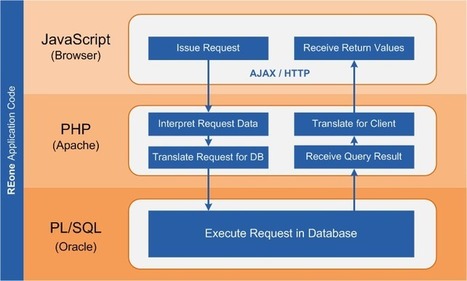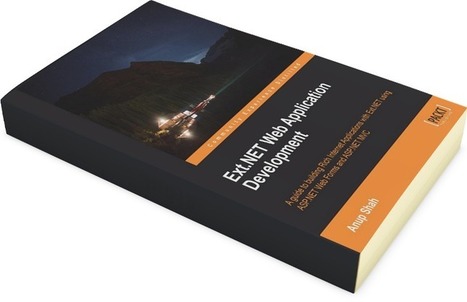This will be useful as a getting started guide in a general sense, but I will also be making comparisons to Sencha Touch along the way. This will allow you to
Get Started for FREE
Sign up with Facebook Sign up with X
I don't have a Facebook or a X account



 Your new post is loading... Your new post is loading...
 Your new post is loading... Your new post is loading...
Current selected tag: 'ExtJS'. Clear
No comment yet.
Sign up to comment
Ext JS 5 introduced support for components in grid cells using the new “widgetcolumn”. At the same time, Ext JS 5 introduced a new type of lightweight component called a “Widget”. There are several widgets included in Ext JS 5, and this article will show you how easy it is to build your own. I've recently been looking into these emerging frameworks and wanted to highlight a few of their interesting features in contrast to ExtJS. This is by no means an objective comparison (and the frameworks are too far apart to really be compared that way), but rather an analysis of some interesting performance-oriented features that are addressing some of the most common performance/load issues associated with large HTML-based web applications like those usually developed in ExtJS. For years ExtJS has been a leading JavaScript development UI framework for web and Hybrid applications. This new version cleans out a series of legacy features and adds many modern enhancements. These include moving towards HTML5, bringing corporate applications to larger touch devices and adding more widgets to an already impressive widget collection. Sencha have made the process of upgrading to ExtJS 5.x from ExtJS4.x fairly trivial, with a built-in compatibility layer giving developers a development-only shim that provides console messages during development alerting them to areas they need to focus on to transition to the new framework. Both of these frameworks define a reference architecture for developing single page web applications, providing developers with the means to:
However, these two frameworks go about solving these problems through fundamentally different approaches. ExtJS vs AngularJS. ExtJS and AngularJS are the two industry leading frameworks for Rich UI development. ExtJS vs AngularJS:
Architectural Differences: I recently put together a tutorial on how to use ExtJS to create a Single Page Application (SPA). Part 1 discusses what an ExtJS MVC Single Page Application looks like and how its code can be structured. Part 2 presents a high-level overview of the code used to power a Single Page Application. Part 3 goes over how the Grid Controller shown in our example application is coded in ExtJS. Part 4 goes into the ExtJS representation of the view that is in our example application. We see why we view certain configurations over others and how you can use those configurations to create interfaces of your own. Part 5 discusses the form controller that represents the pop-up window in our example ExtJS single page application. Part 6 goes more in-detail on how the communication between the edit controller and the grid controller takes place with ExtJS. Two frameworks with a very different approaches, but both with the same driving force – make the web work for web apps.
I’ve been a big fan of Sencha’s ExtJS since I started using it several years ago. When I was first exposed to the framework in its v2.0 days, it was a breath of fresh air compared to anything else out there. It had a well-documented, powerful framework and a comprehensive set of widgets. The grid widget alone scratched enough itches that the rest of the framework was gravy. I haven’t been able to use it on any projects, though, for a couple years, but I have tried to stay up to date on the releases. Unfortunately for Sencha, in the intervening years, the internet has started to catch up and I’ve been taking a much more critical eye to ExtJS. There are still several good parts to ExtJS, but there are also a lot of bad things that will limit its suitability for any future projects.
* The Good Parts * The Bad Parts * The Sweet Spot * What To Do Among other things in this blog post I’ll describe an example of how the usage of real-time can save you 99% of backend requests, while making your code simpler and your user interface snappier along the way. Then, about a year ago, I stumbled across an old friend of mine who happens to be the author ofAutobahn, an open-source real-time framework for Web, Mobile & Internet of Things. It took some time until I was convinced of the simplicity of his technology, but eventually I found that I did not need to understand the inner complications of sending messages over WebSocket from A to B in order to use Autobahn. Once I had WebSocket working in my app, I was just a tiny step away from getting server pushed messages into the client browser. I very much liked this idea to get rid of those refresh buttons everywhere in the frontend. That was a low hanging fruit then and I quickly got some really nice changes in interface design (like live chat, object locking in the frontend and real-time refresh). I have to develop a lot of applications in my web app and I see that grid component of ExtJS may fit in. However, I am not aware of what all things I can do with the This is a typical question that we hear from the business users who wants to design an application by keeping the framework’s capability in perspective. In this article I have tried to put the list of stuff you can do with grid and hopefully that shall enable you to take advantage of the beauty of ExtJS. What are the available options? In this section I will be taking you through some of the commonly seen usage of ExtJS grid panel. While covering all the capabilities of grid may not be possible, I am sure it will be helpful for the business users who want to understand what he / she can do with this component of ExtJS. This article needs continuous improvement to make this further useful. I am looking forward to feedback and suggestion to make this article even more useful. Two frameworks with a very different approaches, but both with the same driving force – make the web work for web apps. When i started working with Ext JS five years ago web development was still pretty hard. Ajax and jQuery along with strong JavaScript advocates like Douglas Crockford, started making JavaScript popular. But two large problems still remained - 1) making the UI look and behave more like a desktop. 2) creating a solid application structure(MV***) was still a big challenge. That’s when i met extjs and i was amazed! |
WebDriver is great, but since a lot of javascript events are happening in the background it’s very difficult to write a easily usable DSL to manipulate the UI. One has to wait for ajax calls to finish, for DOM elements to appear or disappear, and so on. Tests became instable and failed sometimes, even sometimes on the CI build but never on your development environment. It takes more and more time to find & fix those things. A possible solution: SiestaSiesta is a product from Bryntum especially written to unit test Extjs applications, focussing on the UI. Sounds nice, so we decided to check it out as a possible alternative to WebDriver
LET'S TALK ABOUT NEW VERSION JAVASCRIPT FRAMEWORK SENCHA EXTJS 5PROS AND CONS+
While these individual libraries and the resulting custom stack have the potential to do some things very well, the unfortunate reality is that a great deal of the functionality must be gathered together from disparate sources, written in-house and require a dedicated team of maintainers in order to meet the demands of enterprise software development. 
Delchina Angelova's curator insight,
October 27, 2014 11:01 AM
Not sure the compare is fair but questions are good. The most recent post on the Sencha Blog, Declarative Listeners in Ext JS 5, goes over some of the improvements made in the latest ExtJS release to make attaching event listeners to components a little easier. I have been using a small override in ExtJS 4 for a while that offers a similar declarative approach to attaching listeners, but also gives the developer the ability to traverse the component hierarchy or listen to stores. This small override completely changed the way I develop apps using ExtJS. In a nutshell, ExtJS is an insanely powerful framework that makes fancy stuff easy to achieve. It takes time to learn (and I bet a more senior developer would pick it up much faster than I did), but once you bridged the learning curve you have a lot of power at your fingertips. Despite being a big proponent of ExtJS for the reasons mentioned earlier, over time I have become more frustrated with the cons of the framework that I believe are doing serious harm to community involvement in Revolution. Learning ExtJS has been a great business decision (it made up probably a good 85% of my freelance work), but as I'm a big community fan I'd rather see something a bit more.. approachable. 6-part video series on guiding principles for writing a maintainable, easy-to-use, and easy-to-code Single Page Application with ExtJS. Part 1 This is the first of a series of tutorial explaining how to create Single Page Applications using ExtJS. http://www.youtube.com/watch?v=lHtH53bMZZs http://www.youtube.com/watch?v=o3wJ7IOfBJw http://www.youtube.com/watch?v=LKa6tAbA6e4 http://www.youtube.com/watch?v=WaKZGPKqoc8 http://www.youtube.com/watch?v=1ymUDLPORfM
The Sencha framework provides a multitude of data connection opportunities to connect a client side application to the server side. The framework introduces a language agnostic technology to access remote server side methods called Ext Direct. There are several supported server-side environments including PHP, Java, .NET and others however conspicuously missing from the list of server stacks was Node.JS as a backend technology. Some quick research showed a couple of sample implementations utilizing Node.JS, however these examples used older versions of ExtJS and were already a couple of years old. I’ve included some of the articles I used for inspiration while going through this exercise. I thought it would be an interesting exercise to implement Ext Direct utilizing Node.js and document the experience. To make this interesting I utilized some of the more common modules and node frameworks used in node.js web applications such as Express 3.0 and Sequelize. There are obviously a ton of alternative yet valid opinions, methods and techniques on how to properly configure or setup a web application so feel free to use this as either an example or inspiration to implement your own Ext Direct application using Node.JS.
Ext.NET is a component framework built with ASP.NET and Sencha Ext JS
for quicker, better web app development. Ext.NET is an advanced ASP.NET (WebForms + MVC) component framework integrating the cross-browser Sencha Ext JS JavaScript Library. WHO If you are looking to build a rich, modern web application with cutting edge web technologies, unparalleled cross-browser compatibility and an advanced MVC architecture then Ext.NET is for you! WHY Ext.NET is built for developers, by developers. We provide hundreds of Demos in our Examples Explorer. Need a little support? Check out our Developer Bundles. Most of my projects revolve around real-world applications which utilize complex data architecture in SQL databases. Exposing this data using RESTful approaches (more on that in a later blog post) and JSON consumed by the Sencha Model and Store objects is a godsend in developing robust, responsive web/mobile applications. Tutorial on how to write behavior driven tests of ExtJS 3.4 components with Jasmine. Developing your own ExtJS components for your application is more fun and results into more resilient code if you write them hand-in-hand with test code. A solid test basis can also facilitate the task of refactoring your software. Although, test driven development is easy for javascript code, how can ExtJS 3.4 components be tested? Which parts of our components should be tested to accomplish a successful refactoring? Ext JS 4.0 provides a number of ways for custom components to render their HTML content for display: autoEl, html, tpl/data, renderTpl/renderData As I have been learning Ext JS, I have often struggled with knowing which technique is the correct one in a given situation. Here I will briefly discuss the different ways of specifying content, followed by some thoughts on when you might want to use them. |

























